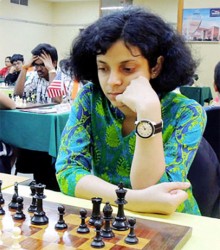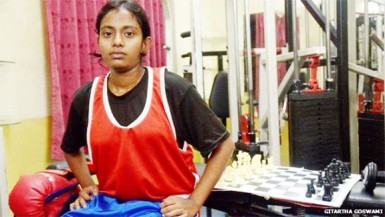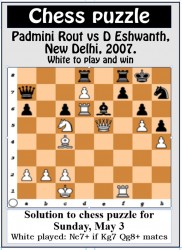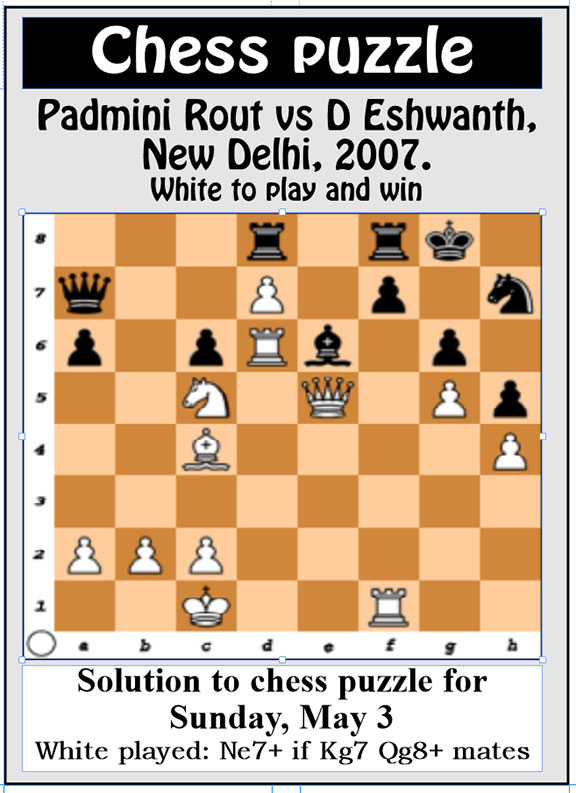British chess grandmaster and one time world championship title challenger, Nigel Short, wrote an article for the Dutch magazine New in Chess recently, titled ‘Vive la Difference’ which claimed, provocatively, that there are genetic reasons why men are more successful in chess than women. The article went viral, was picked up by international news services and generated a worldwide media storm. The storm which Short unleashed with his article, motivated one of India’s top chess players, international master Nisha Mohota to speak.
Nisha has taken the opportunity to describe the situation with women chess players in her country, outlining what can be done to alleviate difficulties which sometimes present themselves. In Guyana, women competitive chess players are few in number. Now, it’s almost nil! Whenever the Guyana Chess Federation hosts a tournament, the turnout of women players is disastrously inhibited. Over the years, that circumstance has been the norm. This is the reason why the column keeps highlighting the path which other developed countries are taking in relation to the integration of chess into schools as a subject. Meanwhile, we can listen to Nisha, and perhaps we can learn from her arguments. Nisha writes:
“What is it that stops young girls from taking up chess in our state and also in the rest of India? Why is it that in an open chess tournament the participation of female players can be counted on our fingers? Why do young, talented girls drop out of chess at a young age and enter into academics? For this we need to understand some facts about chess and the problems faced by women players.
 “The myth goes that chess is only a mind game. Physical fitness does not count. However, this is far from the truth. Yes, chess is a mental gym. One has to use full mental energy to fight out the battle on the chess board. But is mental strength and intellect enough? No. Most of you will be surprised to hear that chess requires complete physical fitness. Physical stamina and strength are essential for proper functioning of the brain during the five to six stressful hours that one has to sit at the chess board. No wonder World Champion Magnus Carlsen plays football or goes to a gym to ‘relax’ on rest days during chess tournaments!
“The myth goes that chess is only a mind game. Physical fitness does not count. However, this is far from the truth. Yes, chess is a mental gym. One has to use full mental energy to fight out the battle on the chess board. But is mental strength and intellect enough? No. Most of you will be surprised to hear that chess requires complete physical fitness. Physical stamina and strength are essential for proper functioning of the brain during the five to six stressful hours that one has to sit at the chess board. No wonder World Champion Magnus Carlsen plays football or goes to a gym to ‘relax’ on rest days during chess tournaments!

“As of today, men play chess better than women. But does that mean they are more intelligent? No. In academics, girls have proved themselves to be as good as, or even better than boys. So, what makes chess different? First of all we must agree that nature has made men and women different. Let’s respect each other’s differences. We can see the difference between a girl and a boy from early childhood. When young boys meet, they love to push each other, fight – this is all fun for them. Ever noticed how young girls behave when they meet each other? They make each other comfortable, smile, laugh, talk, but they normally do not indulge in physical fight. So we see that the fighting spirit required in the game of chess comes naturally to men whereas the peaceful women have to go the extra mile to inculcate this fighting spirit in themselves.”
Continued next week.
This column is saddened by the passing of the inimitable Andrew ‘ Sixheads ‘ Lewis. My condolences go out to his family, relatives and his

friends. I did not know the guy, but all of Guyana knew him. I can recall exactly where I watched his magnificent performance as he seized the world welterweight boxing crown and placed it on his head. The welterweight and heavyweight crowns are the holy grails of boxing. Afterward, I considered him to be the prime motivator of what could be achieved when we set the stars as our limit. He did, and he came out victorious!
Chess games
The following games were played at the 2015 Russian Team Championships in Sochi, Russia, which ends today.
White Leinier Dominguez Perez
Black Bogdan Belyakov
1. d4 Nf6 2. c4 d6 3. Nc3 e5 4. d5 a5 5. e4 Be7 6. f3 Nfd7 7. Be3 Bg5 8. Bf2 Na6 9. h4 Be7 10. Bd3 Ndc5 11. Bc2 O-O 12. a3 Nd7 13. g4 Nb6 14. Qe2 Nc5 15. O-O-O a4 16. f4 exf4 17. Bxc5 dxc5 18. e5 Qd7 19. Nf3 Qxg4 20. h5 Qd7 21. Qe4 Qf5 22. Qe2 Qd7 23. Rdg1 f5 24. Rh2 Re8 25. e6 Qd8 26. Qe5 Bf6 27. Qxf5 Bxc3 28. bxc3 Qf6 29. Qxf6 1-0.
White Vladimir Kramnik
Black Peter Svidler
 1. Nf3 Nf6 2. g3 d5 3. Bg2 g6 4. b3 Bg7 5. Bb2 c5 6. c4 d4 7. b4 Nfd7 8. O-O Nc6 9. bxc5 O-O 10. d3 Nxc5 11. Nbd2 Rb8 12. Ba3 Qa5 13. Qc1 Na4 14. Nb3 Qc7 15. Qc2 Bd7 16. Rae1 Rfd8 17. e3 dxe3 18. fxe3 h6 19. d4 Bf5 20. e4 Bg4 21. e5 Nb6 22. Nh4 Nxd4 23. Qf2 Qxc4 24. Re4 Be6 25. Nxd4 Bd5 26. Ne6 Bxe6 27. Rxc4 Nxc4 28. Bxe7 Rd2 29. Qxa7 Bxe5 30. Nf3 Bc7 1-0.
1. Nf3 Nf6 2. g3 d5 3. Bg2 g6 4. b3 Bg7 5. Bb2 c5 6. c4 d4 7. b4 Nfd7 8. O-O Nc6 9. bxc5 O-O 10. d3 Nxc5 11. Nbd2 Rb8 12. Ba3 Qa5 13. Qc1 Na4 14. Nb3 Qc7 15. Qc2 Bd7 16. Rae1 Rfd8 17. e3 dxe3 18. fxe3 h6 19. d4 Bf5 20. e4 Bg4 21. e5 Nb6 22. Nh4 Nxd4 23. Qf2 Qxc4 24. Re4 Be6 25. Nxd4 Bd5 26. Ne6 Bxe6 27. Rxc4 Nxc4 28. Bxe7 Rd2 29. Qxa7 Bxe5 30. Nf3 Bc7 1-0.
White Radoslaw Wojtaszek
Black Alexander Grischuk
1. d4 Nf6 2. c4 g6 3. Nc3 d5 4. cxd5 Nxd5 5. Bd2 Bg7 6. e4 Nxc3 7. Bxc3 Nc6 8. Bb5 O-O 9. Ne2 Qd6 10. d5 Ne5 11. f4 Ng4 12. Bxg7 Kxg7 13. h3 Qb4+ 14. Nc3 Nf6 15. Qc2 c6 16. dxc6 bxc6 17. Be2 Rd8 18. Rd1 Rxd1+ 19. Kxd1 e5 20. fxe5 Qd4+ 21. Kc1 Qxe5 22. Bc4 Rb8 23. Qf2 Rb4 24. Bb3 c5 25. Rf1 Bb7 26. Bc2
Bc6 27. Qf4 Qxf4+ 28. Rxf4 Nd7 29. Rf2 Ne5 30. b3 Rd4 31. Rd2 f5 32. exf5 Rxd2 33. Kxd2 Bxg2 34. fxg6 hxg6 35. h4 Nf3+ 36. Ke3 Nxh4 37. Na4 Kf6 38. Nxc5 Nf5+ 39. Kf2 Bd5 40. Nd7+ Ke6 1/2-1/2.
White Levon Aronian
Black Dmitry Andreikin
1. c4 e5 2. Nc3 Nc6 3. Nf3 g6 4. d4 exd4 5. Nxd4 Bg7 6. Nxc6 bxc6 7. e4 Ne7 8. Be3 d6 9. Bd4 Bxd4 10. Qxd4 O-O 11. c5 dxc5 12. Qxc5 Qd6 13. Qxd6 cxd6 14. O-O-O Rd8 15. Rd2 Be6 16. Be2 Rd7 17. Bd1 Nc8 18. Ba4 Rc7 19. Rhd1 Rb8 20. h3 Rb4 21. Bc2 g5 22. h4 h6 23. hxg5 hxg5 24. Rh1 Kf8 25. Rh5 Rcb7 26. b3 f6 27. g3 Rg7 28. f4 Rbb7 29. f5 Bg8 30. e5 fxe5 31. f6 Rgf7 32. Ne4 d5 33. Nc5 Nd6 34. Rxg5 Rxf6 35. Nxb7 Nxb7 36. Rxe5 Nd6 37. Rd4 Bf7 38. Rf4 Rh6 39. g4 Rh1+ 40. Kb2 Rh2 41. Rf6 Ne4 42. Rxc6 Nf2 43. Ka3 Nxg4 44. Rc8+ 1-0.






